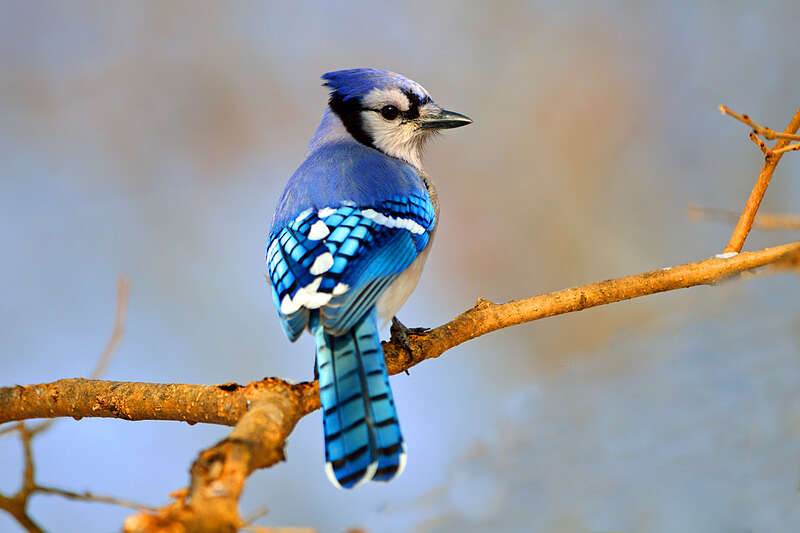What do Blue Jays look like?
The blue jay is a medium-sized bird with a long tail. As their name suggests, they are bright blue on the upper body with black, blue and white bands on their tail and wings. The breast is white and the face and neck are also white with a black band, or bridle, around them. The bill is strong and black, and the head has a small blue crest.
The blue jay uses this crest to communicate by making it stand up or lie flat.
The blue jay bird is what is known as a passerine bird, which means it has feet with three toes that point to the front and one toe that points to the back. This makes it easy for the feet to perch on branches.
Where do Blue Jays live?
The blue jay bird is found in much of central and eastern North America. They are slowly spreading north west and are also found in southern Canada.
What do Blue Jays eat?

The blue jay bird’s diet mainly consists of seeds, nuts and acorns. They will also eat some small insects and other creatures such as beetles, worms and caterpillars.
Blue jays have been known to eat the eggs of other birds and also nestlings, and because of this they’ve got something of a bad reputation. In truth though, they’re mostly vegetarian.
Blue jays love to eat acorns. They will often store them in the ground for later and then forget about them. This helps the trees to spread. They also like peanuts, sunflower seeds and suet. If you want to attract them to your yard, put out feeders filled with these. Open platform feeders are the best type of feeder for blue jays.
Blue jays drink fresh water from ponds and streams, and will also drink from garden fountains and bird baths.
Blue jays don’t always migrate and you may find you still get them as visitors to your back yard even during the cold winter months. In fact, you may even find that you get completely different blue jays visiting you during winter than you do in summer.
Blue jays can be aggressive and scare other birds away from your feeders. They have been known to kill and eat smaller birds.
Mating
The blue jay is a very social bird and it’s not often that you will see one on its own. They’re mostly seen with at least one or two other blue jays or as part of a flock.
Blue jays remain with their mating partner for life. The mating season lasts from the middle of March through to July.
Both the male blue jay bird and the female blue jay bird will take part in rearing the young but only the female broods them. The male blue jay will bring the female food while she broods. Blue jays normally lay between three and six eggs and the eggs normally hatch after about just over two weeks. Usually blue jays will only have one lot of chicks each year, although sometimes they’ll have two.
Communication and Blue Jay bird song

The blue jay bird communicates by singing and by using its crest. The crest stands erect when they’re stressed or annoyed, but when they’re at ease you may barely even be able to see it as it lies flat.
Blue jays are known for being very noisy birds, and they love to sing and call out to other birds. You’ll soon know if you have blue jays visiting your yard because you’ll be able to hear the blue jay sounds! They’re able to make a lot of different sounds and they’ll even imitate the call of hawks. They’ll do this to scare off other birds. You’ll even sometimes hear blue jays mimicking humans. You can listen to a typical blue jay bird call here.
Habitat and nesting
The blue jay is an adaptable bird and will live in almost any habitat although they prefer woods and forests, in particular ones that have oak trees in them. Having said that, they’re well adapted to living in urban city areas and are common visitors to backyard feeders.
The blue jay bird is a non-cavity nester. It builds its cup-shaped nest on the branches of trees or large bushes, preferring to nest in evergreen trees. The male will usually collect all the material for the nest, and the female will build it. The nest is built out of mud, grass, roots and twigs.
You can encourage blue jays to nest in your yard by putting up shelf nests. If your yard is big enough you can also plant oak trees.
Baby Blue Jay birds
Baby blue jay birds don’t have the vivid blue color of the adults. In fact, they’re born both bald and blind and their mouths have a pink or red lining.
They will start to venture out from their nest when they’re between seventeen to twenty one days old but will stay with the parents for another month or two after this. During this time they’ll continue to be fed by the parents.
Blue Jay predators
The blue jay is a relatively poor and slow flier and this makes it easy prey for hawks and owls and other large birds of prey. Squirrels, tree snakes, cats, dogs and other animals will all target blue jay eggs and baby birds.
While squirrels won’t eat blue jays, they will scare them away from your feeders.
For more information on how to identify the blue jay bird and many other birds in your yard, see our backyard bird identification guide here. And you may also like our article on the Northern Cardinal bird.

